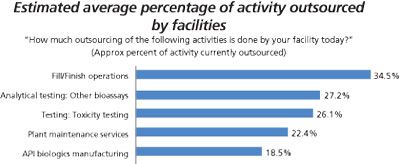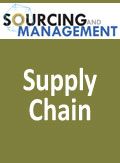Assay Testing Shifts to Outsourced Operations
PTSM: Pharmaceutical Technology Sourcing and Management
More biopharma companies choose outside service providers for assay testing.
A number of recent workforce surveys have shown that professional workers are continuing to put in longer hours. The Great Recession is partly to blame; professional workers were laid off, and those remaining today continue to do the work of two or more. But as the global economy has improved, the number of employees has not. Therefore, to get the needed productivity, outsourcing is becoming a standard strategy.
Biopharmaceutical manufacturers already outsource plenty of activities, and they’re clearly indicating this trend is not likely to be reversed. According to BioPlan Associates’12th Annual Report and Survey of Biopharmaceutical Manufacturing Capacity and Production (1), the push to outsource is being institutionalized. Non-core functions, such as assay testing, are a bellwether: Once again, the industry has voted this activity the most likely to be dumped.
Each year, BioPlan’s survey brings in more than 200 qualified biopharmaceutical manufacturers who share their perspectives on market trends and opportunities. Back in 2012, the survey showed a large jump in the share of survey respondents who projected significantly greater levels of outsourcing of bioassay testing. Since then, this has consistently ranked as the top area of projected outsourcing increases.
In the 2015 survey, however, bioassay testing stands out relative to 24 other common bioprocessing activities. Indeed, when respondents were asked which activities will be outsourced at significantly higher levels at their facility during the next 24 months, 40.9% of the industry cited “analytical testing: other bioassays.” This percentage was double the share of respondents indicating they expect greater levels of fill/finish outsourcing (19.7%), the next highest activity in terms of future outsourcing growth. Beyond assay testing and fill/finish, other activities in the top five for future outsourcing activity include downstream process development, validation services, and API biologics manufacturing (see Figure 1).

Figure 1: Selected activities: Future outsourcing growth.
Furthermore, of the 10 most popular activities projected for future outsourcing growth, only three were cited by a higher share of respondents in 2015 compared to 2014. Aside from bioassay testing (40.9% vs. 33.9% in 2014), the others were cell-line development and upstream process development, each with only slight increases. In other words, while enthusiasm for outsourcing appears to have flattened out for most activities, it’s still going strong for analytical testing of bioassays.
Most likely, this may be the result of continued outsourcing of analytical methods based on the need to have costly, high-maintenance equipment in almost constant operation, as well as the need for specialized staff able to run the assays and prepare the requisite regulatory filings, which may occur only intermittently.
US vs. European outsourcing of assays
Staffing requirements may be a larger influence in Europe than in the United States. In the 2014 study, Western European respondents were twice as likely as US respondents to report difficulties in hiring high-tech assay staff (15.8% vs. 7.3%) at their facilities. Perhaps it’s not a coincidence that in the 2015 survey, European respondents were particularly enthusiastic about future outsourcing of assay testing, at almost four times the rate of any other activity. While this activity was also projected for future increases by the largest proportion of US respondents, it didn’t distance itself from the pack at nearly the same level.
Future increases in outsourcing of assay testing may also be due to most companies currently only outsourcing this activity to a minor degree (see Figure 2). While assay testing is again the most commonly outsourced activity, it tends to be outsourced at fairly low levels in relation to other activities. A look at the five most commonly outsourced activities reveals that:
- Approximately 86% of respondents are outsourcing analytical testing of other bioassays to some degree, and an average of 27% of these operations are outsourced.
- 73% are outsourcing validation services, with an average of 18% of this activity being outsourced.
- An equal 73% are outsourcing some fill/finish services, but with these respondents estimating outsourcing an average of 35% of these operations overall.
- Some 72% outsource toxicity testing, for an average of 26% outsourced.

Figure 2: Average percentage of activity outsourced.
These results indicate that while toxicity testing is a less commonly outsourced activity, it is outsourced on average to almost the same degree as assay testing. Meanwhile, more than one-third of facilities’ fill/finish operations are currently being outsourced, despite nearly three-quarters outsourcing this activity to some degree.
As such, the increase in future assay testing outsourcing may be the result of those already outsourcing this activity planning to do so at higher levels in the future.
Trends in other outsourcing activities
The BioPlan survey shows that the popularity of some outsourcing activities has flattened out, a fairly understandable result given the extent of growth witnessed in recent years. Some notable declines in terms of outsourcing popularity include toxicity testing (72% outsourcing to some degree, down from 87% in 2014) and fill-finish operations (73%, down from 80% in 2014). Still, higher proportions of respondents this year reported having outsourced activities including:
- contract research-laboratory (66%, up from 59%)
- project management services (52%, up from 43%)
- downstream process development (41%, up from 36%).
In terms of outsourcing levels, most activities appear to be outsourced to a slightly lesser degree in 2015, with the only standouts in terms of decreased levels being toxicity testing (26.1% of these activities on average being outsourced, down from 35.4%) and cell line stability testing (13.4% on average, down from 19.6%). Nevertheless, for the most part, reported levels of outsourcing are in the range set in prior years.
Additionally, it is expected that the slight dip in levels of validation services being outsourced will be temporary, as the increasing penetration of single-use devices will likely spur more spending in this area. Finally, while more respondents are outsourcing design of experiments (DoE), this activity is being outsourced to a lesser overall degree, suggesting that companies newly outsourcing this quality activity are testing the waters.
Conclusion
Although survey results suggest that the market growth for outsourcing of certain activities is flattening, the overall outsourcing market appears to be healthy, as many respondents predict spending increases to come. In fact, a slight majority forecast some level of spending increase, though most of those will be limiting their increases to less than 25%. Overall, it is estimated that spending on outsourcing of R&D and manufacturing will grow by 13% in 2015; this is a healthy growth rate, and it’s consistent with the growth in overall biopharmaceutical sales.
While some increases in outsourcing budgets are targeting the more common outsourced services, such as assay testing and fill/finish operations, other activities are showing increasing importance, such as DoE and quality by design. These activities represent smaller budgets, so in years to come, their growth rate may likely be even greater than the big-ticket outsourcing activities.
Reference
1. BioPlan Associates, 12th Annual Report and Survey of Biopharmaceutical Manufacturing Capacity and Production (Rockville, MD, April 2015), www.bioplanassociates.com/12th.

Pharmaceutical Tariffs Are Imminent: How Industry is Bracing for Impact
April 16th 2025On April 14, 2025, the Trump Administration launched a national security-driven investigation into pharmaceuticals, a move that will likely result in tariffs being placed on pharmaceutical drugs, ingredients, and other components that are imported from outside of the United States.
Drug Solutions Podcast: A Closer Look at mRNA in Oncology and Vaccines
April 30th 2024In this episode fo the Drug Solutions Podcast, etherna’s vice-president of Technology and Innovation, Stefaan De Koker, discusses the merits and challenges of using mRNA as the foundation for therapeutics in oncology as well as for vaccines.